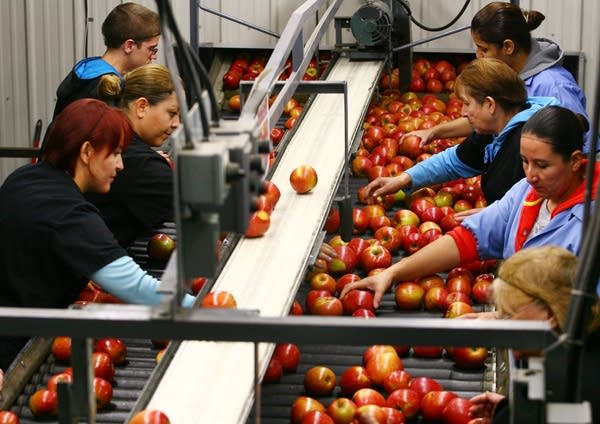Tough harvest this year for Minnesota apple growers
Go Deeper.
Create an account or log in to save stories.
Like this?
Thanks for liking this story! We have added it to a list of your favorite stories.

Apple lovers may have a hard time finding Minnesota-grown Honeycrisp apples this year.
Unusually warm weather in March, followed by a hard frost in April, killed off a lot of apple blossoms. A few months later, thousands of apples that were left on trees were damaged from summertime hail storms and drought, a big blow to the $12.6 million apple industry.
"Normally, even this time of year, we'd be just fine," said Fred Wescott, whose Elgin orchid typically produces 600 bushels an acre. "We'd have all kinds; these trees would be just loaded with fruit... The significant damage this year, no matter how you cut it, is the fact that there is no fruit."
For the untrained eye, the rows of bushy green apple trees at the Wescott Orchard look healthy. But to Wescott, they're practically naked.
Turn Up Your Support
MPR News helps you turn down the noise and build shared understanding. Turn up your support for this public resource and keep trusted journalism accessible to all.
"This tree right here maybe has half of a normal crop," he said while walking the orchard. "This tree right here has 15 percent of what it should have. That tree there doesn't have any."
Wescott's orchard has a patchwork of apples, some healthy, others dented and bruised from hail damage. This year, he estimates he'll see only 150 bushels an acre.
Inside a processing facility next to Wescott's orchard, workers sort through some of the last batches of Minnesota-grown Haralson apples. The facility processes apples for 25 local growers. During winter months, Wescott also imports and distributes apples from Washington state and South America. This year, he expects the Washington crop to be in such high demand that South American growers will ship fruit earlier to fill in the gaps of the supply chain.

Minnesota is home to about 150 apple growers. In 2010, they produced nearly 16 million pounds of fruit. That could drop by as much as 40 percent this year, University of Minnesota Apple Breeder David Bedford estimates.
"There are parts of the state and individual growers that might only have 20 percent of a normal crop," Bedford said. "And others that are up in the 80, 90 percent of normal."
Even though some growers dodged the challenging weather, Bedford said, Minnesota as a whole will produce far fewer apples than normal this year.
"The good news is that the fruit actually tastes as good as I've ever tasted it," Bedford said. "The bad news is because of the shortage of fruit the prices are higher."
"The good news is that the fruit actually tastes as good as I've ever tasted it," Bedford said. "The bad news is because of the shortage of fruit the prices are higher."
Consumers can expect to pay from $1.50 to $3.50 a pound, depending on the variety, he said. Minnesota's most desirable apple, the Honeycrisp, may be the hardest to find.
That's because two separate hail storms hammered Pepin Heights. The Red Wing orchard produces the majority of the Minnesota's Honeycrisp apples.
Pepin Heights Vice President Timothy Byrne said one 26-minute hail storm wiped out most of the orchard's apples and left it with its worst apple crop ever.
"We suffered damage to 100 percent of the fruit that we had on the trees," Byrne said. "We have only a minimal harvest crew out there gathering what little bit of good fresh market fruit we've got."
Some of the damaged apples were used for products like ciders and applesauce, Byrne said. Better looking apples are for sale at the company's retail store just south of Red Wing.
The company will begin to import apples from New Zealand to offset some of its losses. But Byrne said apple lovers shouldn't expect to find Pepin Heights Honeycrisp apples in grocery stores this fall.
Dear reader,
Political debates with family or friends can get heated. But what if there was a way to handle them better?
You can learn how to have civil political conversations with our new e-book!
Download our free e-book, Talking Sense: Have Hard Political Conversations, Better, and learn how to talk without the tension.






